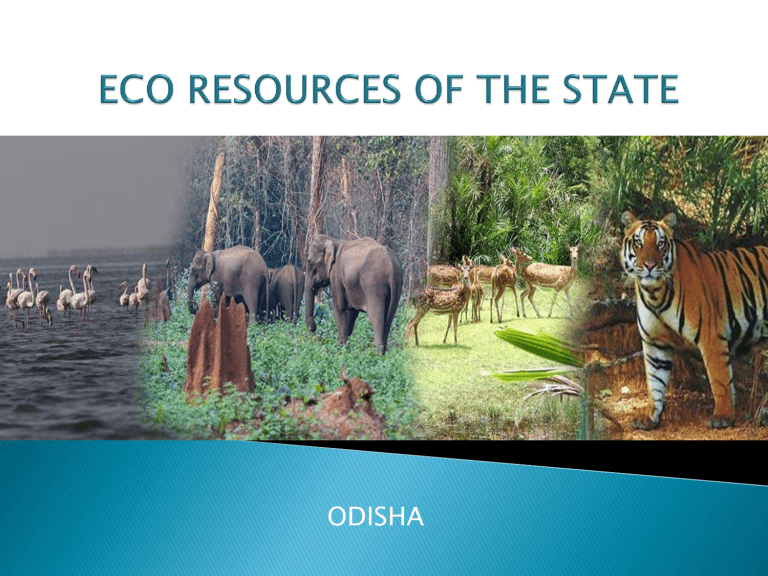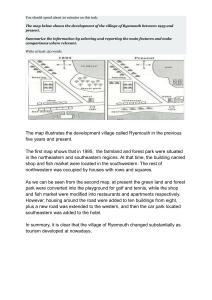Odisha Ecotourism: Resources, Wildlife & Cultural Heritage
advertisement

ODISHA Its area is 155845. 48 sq. km The State is surrounded by Bay of Bengal on east. West Bengal on North-East, Jharkhand on North, Madhya Pradesh on West and Andhra Pradesh on south Out of all rivers Mahanadi is the biggest one. It is originated at Amarkantak plateu of Mahdhya Pradesh. The length of the river is 858 km. Besides Mahanadi, there are other rivers like Subamarekha, Budhabalang, Baitarani, Brahmani, Rushikulya, Bansadhara present in the states. There are two big lakes namely Chilika and Anshupa in the state. This plain has very fertile soil and so produces plenty of food grains like rice, groundnut sugarcane etc. Nearly 32 per cent of the area of the state is now covered with forest. The forest of the state provides tree like Teak, Sal, Shisu, Khaira, etc. besides bamboos in planty. Nearly eightly percent of forest in the state is of deciduous type. This type of forest provides many varieties of valuable tree for housing and industry purposes. Besides this, forest also gives kenduleaves in plenty for bidi industry. Similipal in Mayurbhanj, Badrama in Sambalpur are famous for tigers and other animals. Chilika is famous for its bird’s sanctuary. The minerals like Iron ore, Manganese, Chromite, Bauxite and limestone’s are plentily available at different places of the State. Besides these minerals Orissa has a large reserve of coal at places like Angul, Jharsuguda etc. Origins The term was first used in the years 1965 by Nick Hetzer. The first defination came in 1983 by Mexican architect Héctor Ceballos-Lascuráin; who defined it as "That form of environmentally responsible tourism that involves travel and visitation to relatively undisturbed natural areas with the object of enjoying, admiring, and studying the nature (the scenery, wild plants and animals), as well as any cultural aspect (both past and present) found in these areas, through a process which promotes conservation, has a low impact on the environment and on culture and favors the active and socioeconomically beneficial involvement of local communities." According to the definition and principles of ecotourism established by The International Ecotourism Society (TIES) in 1990, ecotourism is:[4] "Responsible travel to natural areas that conserves the environment and improves the well-being of local people.“ Objectives Minimizing enviromental impacts Respecting the host culture Maximizing the benefits to local communities Maximizing tourist satisfaction Strengthening economy Long term benefits to the local community and the local enviroment. 1. ◦ ◦ ◦ ◦ ◦ ◦ ◦ Regeneration Employment Improved social services Research Protection of Flora and fauna Growth of species Protection of wild life Education 2. ◦ ◦ ◦ Research and development To tourists Tti stakeholders like host community, professionals, NGOs, governments etc. Minimizing negative impact 1. ◦ ◦ ◦ ◦ ◦ ◦ Littering Erosion Displacement of animals Pollution Poaching Cultural erosion Note: It represents around 15% of all tourism expenditure and growing at a rate of 5% per year. Eco Lodges Camping Hiking Bike riding Boat rides Safari Bird Watching Star Gazing Wild life spotting Adventure like surfing, zipling, zorbing, rock climbing etc CAMPING BIRD WATCHING Boat ride Jungle Safari Zorbing Rock climbing 1. 2. 3. 4. 5. 6. Vast forest reserves Unique water bodies Flora, Fauna and Wildlife Rural Life Tribal Communities Cultural Heritage Nearly 32 per cent of the area of the state is now covered with forest. The forest of the state provides tree like Teak, Sal, Shisu, Khaira, etc. besides bamboos in planty. Nearly eightly percent of forest in the state is of deciduous type. This type of forest provides many varieties of valuable tree for housing and industry purposes. Besides this, forest also gives kendu leaves in plenty for bidi industry. Popular National Parks & Wildlife Sanctuaries in Odisha Chilika Lake. ... Bhitarkanika National Park. ... Chandaka Elephant Reserve. ... Debrigarh Wildlife Sanctuary. ... Nandankanan National Park. ... Simlipal National Park. ... Ushakothi Wildlife Sanctuary. ... Tikarpada Wildlife Sanctuary. There are 479 species of birds, 86 species of mammals, 19 species of amphibians and 110 species of reptiles present in Odisha. The state is also an important habitat for the endangered olive ridley turtles and Irrawaddy dolphins. Odisha is a confluence of the Aryan, Dravidian and Adivasi cultures. Ruled by various kings and dynasties, Odisha has acquired many a traditions in its wake. Thus Odisha can best be defined through its racial and cultural amalgamation that lives through its heritage. For a tourism aspect cultural heritage can be divided into ◦ ◦ ◦ ◦ ◦ Dance and music Fairs and festivals Art and paintings Textiles and handlooms Temple architecture Odissi Music is a classical form consisting of all the necessary ingredients common to Hindustani and Karnatic Music. The Odissi dance is evolved from the millennium old dance form called Mahari that used to be performed at the temple of Lord Jagannath at Puri by devadasi dancers called maharis. Apart from the classical Odissi, Chaau is also a prominent dance form in the world of Odisha music and dance. It is the dance of warriors to the accompaniment of indigenous music instruments. There are festivals that are common, but the celebration remains unique to a region. Chandan Yatra, Snana Yatra and Ratha Yatra are observed with special gaiety and fervour at Puri although the lastmentioned one is celebrated at Baripada, Athagarh, Dhenkanal, Koraput and other places even outside the state. Durga Puja is observed throughout the state, more particularly at Cuttack. Kali Puja or Diwali is celebrated in different parts of Odisha. Bali Yatra of Cuttack on the full moon day in the month of Kartika reminds the glory of Odishan traders in the long past. Pattachitra is predominantly icon painting. Some of the popular themes of this religious art are The Badhia (a depiction of the temple of Jagannath); Krishna Lila (an enactment of Jagannath as Lord Krishna displaying his powers as a child); Dasabatara Patti (the ten incarnations of Lord Vishnu); and Panchamukhi (a depiction of Lord Ganesh as a five-headed deity). The village of Pipili, Puri, is well known for its applique work, also known as Chandua (Odia: ଚାନ୍ଦୁ ଆ Cānduā). Odisha has large concentration of tribal population in thecountry. Out of 427 Scheduled Tribes of the country, Odishahas 62 tribal communities who constitute 27.08 percentof State’s population (2001). The tribal communities livingin the State range from small communities like Chenchu,Bonda, Juanga, Didayi, to large communities like Munda,Santalas, Kondh, Oraon, Saora and Bhuyan. Almost 44.21percent of the total land area of the State has beenconstitutionally declared as Scheduled Area, which coversmost of the districts except the coastal districts and fewin-land areas. The districts largely dominated by ScheduledTribes are Malkangiri (58.51%), Mayurbhanja (57.87%),Nawarangpur (55.26%), Rayagada (54.99%), Sundargarh(50.74%), Koraput (50.67%), Kondhaland (50.13%),Keonjhar (44.62%), Gajapati (47.88%), and Jharsuguda(33.31%) (1991 Census of India). The tribal communitiesof the State can be categorised as hunter-gatherernomads; hunter-gatherer and shifting cultivators; simpleartisans; settled agriculturists; industrial and urbanunskilled and semi-skilled workers (Behura, 1990-93) Situated on the banks of the Mahanadi river, and adjoining the Satkosia gorge, Muduligadia, a tiny hamlet in the Nayagarh district with barely thirty-five households holds a unique distinction. In 2019, it became the first village in Odisha to attain selfsustainability with zero-waste and 100% eco-friendly initiatives of livelihood. One might find other eco-villages or experiential eco-resorts in Odisha. But what keeps Muduligadia a class apart is that it was the first ever hamlet to be remodelled into an eco-village exclusively by the community members. Their hard work and dedication deserve the sole credit for this incredible achievement. Anshu Pragyan Das, the formal Divisional Forest Officer of Mahanadi Wildlife division was instrumental in spearheading this transition. Transforming a Community with Sustainability Living in the buffer zone of Satkosia Tiger Reserve, Muduligadia’s residents have traditionally engaged in gathering forest resources like honey and timber. They used firewood for cooking and drew water from the Mahanadi river. Without proper awareness about the environment and hygiene, the villagers used to bathe and wash in the river, and use the same river water for drinking purposes. Open defecation was rampant, often leading to disease breakouts in the village. Previously, household garbage would be thrown astray at the roadsides or even into the Mahanadi river, leading to abject pollution. Now, the villagers themselves have decided on a “No-Litter” policy and installed several common public dustbins along the village roads. Household garbage is deposited every day in these community dustbins from where recycling is also done. The villagers have also pledged to make their village 100% plastic-free. The project has also pushed them towards organic farming. Earlier, agriculture was never of significant importance in Muduligadia, though some families occasionally cultivated seasonal vegetables and grains — resorting to conventional chemical farming for the lack of better understanding. Presently, the village practises organic farming using cow dung manure. “Our lives have improved beyond measure” If you are a tourist strolling through the lanes of Muduligadia, you will be mesmerised by the intricate paintings and motifs on the walls of the village homes. While making their abode eco-friendly, the villagers have also beautifully showcased their traditional art to the world, by decorating the outer walls of their thatched mud huts. They have also decorated the village roads by planting more trees and replacing weeds with lush, green grass. A common puja place for the entire village has also been set up, overlooking the foothills of Satkosia. “Eco-tourism improved our lives beyond measure,” expresses Prakash Behera, a resident of Muduligadia. “Last year, the village was frequented by tourists from across the world and they appreciated the model of sustainability. Most of us earned reasonably well,” he shares, adding that due to the Coronavirus pandemic and the unprecedented ban on tourism, they are currently living in uncertainty, and waiting for tourists to set foot in the hamlet once again. Presentation by Bhabatosh Dehury


